A few weeks ago, I noticed my Husqvarna chainsaw was no longer performing as it had in the past. There were also more emissions coming from it than before.
I checked the air filter immediately, and it was in great shape. That is when I decided to try adjusting the fuel mix ratio.
And to my surprise, the saw soon began to perform flawlessly and emit fewer emissions after correctly mixing the fuel.
Husqvarna chainsaws require a fuel mix ratio of 50:1 (2%) when running 75cc engines, while a 33:1 (3%) ratio may apply to engines over 75cc.

I will first introduce the fuel mix ratio in the article. Next, I will describe the right ratios for Husky saws as well as explain how to apply them.
Let’s dive right in!
What Does Fuel Mix Ratio Mean In Chainsaws?
In case you didn’t know, the fuel mix ratio refers to the proportion of gasoline to the oil used in a saw. It specifies the amount of oil that should be added to gasoline to create the correct mixture for the engine.

Two-stroke engines, like the ones in your chainsaw, use oil and gasoline to lubricate and cool the machine during operation. Both of them are equally crucial, as gasoline revs up the motor, while the oil provides lubrication.
Remember that too much oil or gasoline can damage or malfunction the chainsaw. Hence, you should always adhere to the manufacturer’s recommended ratio.
What’s The Correct Fuel Mix Ratio For Husqvarna Chainsaws?

As per Husqvarna guidelines, the fuel/oil ratio should be 50:1 for all Husqvarna products powered by 75cc or larger engines. Here is an example for further clarification:
According to the 50:1 fuel mix ratio, for every 50 parts of gasoline, 1 part of oil should be added.
Having said that, some chainsaws have much more power than 75cc. If you have one built for heavy-duty cutting tasks, it may run way better with a 33:1 mix.
Let’s talk a little bit more about these two ratios.
- 50:1 Ratio
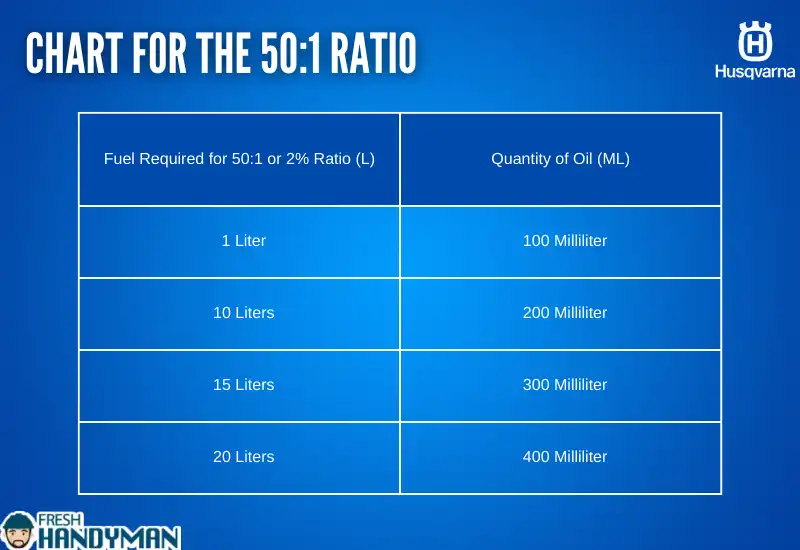
The 50:1 (2%) ratio is suitable for chainsaws with at least 75cc of power. However, this is only applicable if you choose Husqvarna two-stroke oil.
The Husqvarna concrete saw fuel mix ratio also stands at 50:1. Several Husqvarna chainsaw models can be used with the 50:1 ratio, including the 240, 365, 439, 450, 455, 460, 545, and 555.
Here is a chart for those who wish to use the 50:1 ratio:
| Fuel Required for 50:1 or 2% Ratio (L) | Quantity of Oil (ML) |
|---|---|
| 1 Liter | 100 Milliliter |
| 10 Liter | 200 Milliliter |
| 15 Liter | 300 Milliliter |
| 20 Liter | 400 Milliliter |
- 33:1 Ratio

I know some loggers won’t use the oil mentioned above because of the air-cooled and two-stroke engines on their chainsaws. They may favor JASO FB or ISO EGB more.
For them, the 33:1 (3%) ratio is perfect.
Let’s look at the chart explaining how much oil and fuel should be blended for a perfect 33:1 mix.
| Fuel Required for 33:1 or 3% Ratio (L) | Quantity of Oil (ML) |
|---|---|
| 1 Liter | 152 Milliliter |
| 10 Liter | 303 Milliliter |
| 15 Liter | 455 Milliliter |
| 20 Liter | 600 Milliliter |
- Other Fuel Mix Ratios
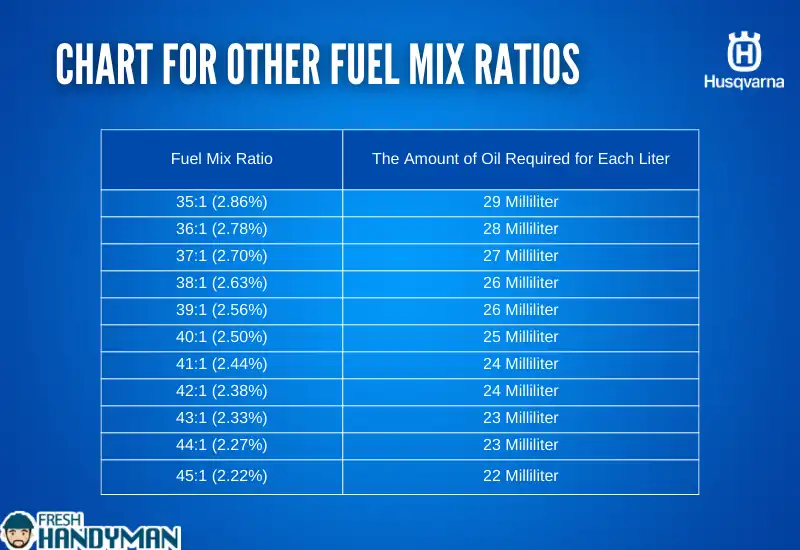
As far as Husqvarna chainsaws are concerned, the fuel ratios mentioned previously are undoubtedly the most effective.
However, you can also use other ratios depending on your application. Let’s see them.
| Fuel Mix Ratio | The Amount of Oil Required for Each Liter |
|---|---|
| 35:1 (2.86%) | 29 Milliliter |
| 36:1 (2.78%) | 28 Milliliter |
| 37:1 (2.70%) | 27 Milliliter |
| 38:1 (2.63%) | 26 Milliliter |
| 39:1 (2.56%) | 26 Milliliter |
| 40:1 (2.50%) | 25 Milliliter |
| 41:1 (2.44%) | 24 Milliliter |
| 42:1 (2.38%) | 24 Milliliter |
| 43:1 (2.33%) | 23 Milliliter |
| 44:1 (2.27%) | 23 Milliliter |
| 45:1 (2.22%) | 22 Milliliter |
Things You Need To Do Before Mixing Fuel
Fuel mixing is vital both for preventing contamination and ensuring its efficiency.
Nevertheless, if you focus solely on fuel mixing, chances are contamination will still occur. It is because a variety of factors affect fuel quality. Here are some of them.

- Proper Storage Of Fuel
Many people do not realize that dirty fuel tanks can severely damage fuel quality.
Unfortunately, a lot of folks are using old, filthy containers. Instead of using such items, you should rely on a good jerry can.
Moreover, if you want the absolute best that won’t harm your fuel at all, consider using the Husky Combi Can. It has a tool storage compartment and no spill valves, which are both extremely useful.
And for those of you who use two-stroke chainsaws, a dedicated tank is also available.
- Using Suitable Unleaded Fuel
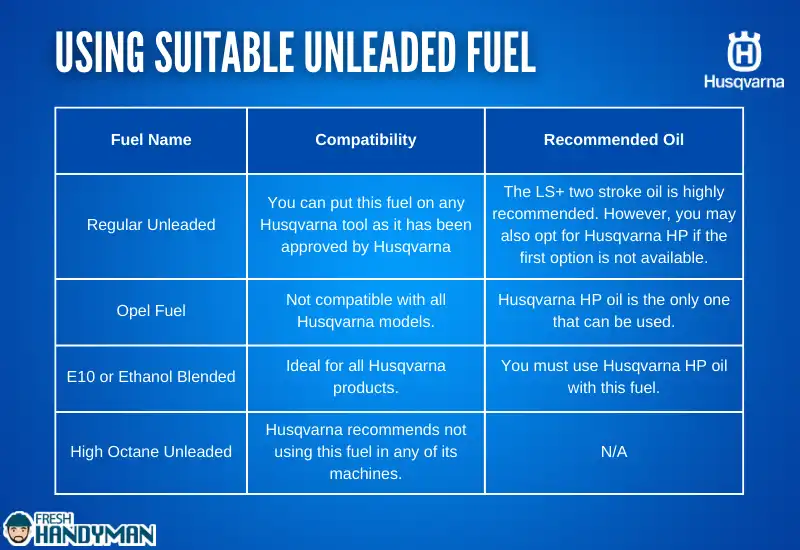
There are times when the fuel mix does not produce the results expected. Using the wrong fuel is to blame for this.
Remember that Husqvarna chainsaws cannot run on any fuel. There are some specific types of fuel that will make your saw perform optimally. Let’s check them out in the chart below.
| Fuel Name | Compatibility | Recommended Oil |
|---|---|---|
| Regular Unleaded | You can put this fuel on any Husqvarna tool as it has been approved by Husqvarna. | The LS+ two stroke oil is highly recommended. However, you may also opt for Husqvarna HP if the first option is not available. |
| Opel Fuel | Not compatible with all Husqvarna models. | Husqvarna HP oil is the only one that can be used. |
| E10 or Ethanol Blended | Ideal for all Husqvarna products. | You must use Husqvarna HP oil with this fuel. |
| High Octane Unleaded | Husqvarna recommends not using this fuel in any of its machines. | N/A |
- Using Suitable Oil
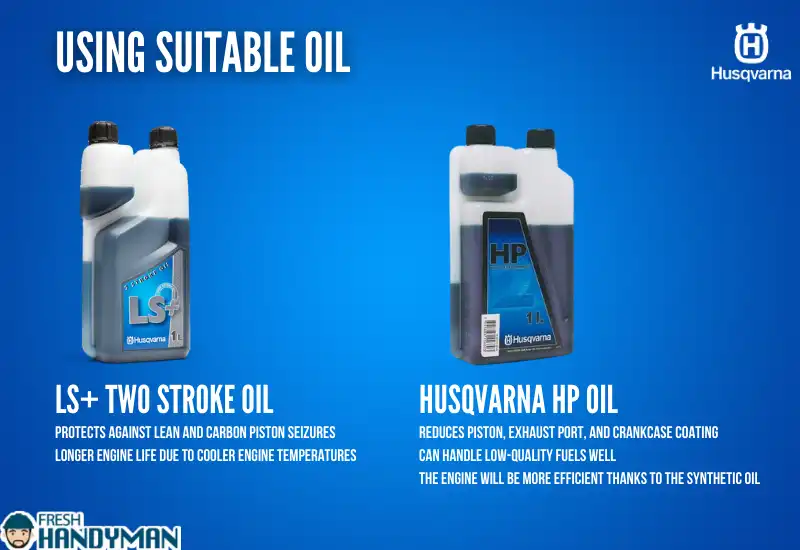
Okay, I’m done with the fuel and storage of it. Nevertheless, there is another important factor that you must take into consideration. Yes, you guessed it right, it’s oil.
Husky saws, unfortunately, cannot operate on any type of oil mix. Let me show you which ones are the most effective.
- LS+ Two Stroke Oil
If you use your chainsaw in a densely populated area, go for LS+ oil. It combines mineral oil with synthetic oil to reduce emissions to a minimum. Here are some more features of it:
- Protects against lean and carbon piston seizures
- Longer engine life due to cooler engine temperatures
In some cases, LS+ oils are formulated specifically for water-cooled engines. Using them on non-water-cooled engines is not advisable as this may severely damage the saw.
- Husqvarna HP Oil
I do not consider LS+ to be a bad oil. If anything, it is an excellent oil. Nonetheless, it poses many compatibility issues since the oil is two-stroke.
This is where the HP (high-performance) oil stands out. It hardly has any restrictions, and you can pretty much use it with any fuel, even regular unleaded fuel. Let’s see what else it offers:
- Reduces piston, exhaust port, and crankcase coating
- Can handle low-quality fuels well
- The engine will be more efficient thanks to the synthetic oil
How Do I Mix Husqvarna Chainsaw Fuel?
Here is a step-by-step guide on how to mix fuel in your Husqvarna chainsaw. Prior to starting, gather the following items:
- Your Husky saw (it should be turned off and cooled)
- Unleaded fuel
- Oil for Husqvarna’s two-stroke engines
- Cloth for wiping up spills
- A clean container used to store fuel

STEP – 1: Ensure sufficient ventilation
Organize all the materials needed for the project. Before proceeding with the main task, be sure that the area you are in has adequate ventilation.
STEP – 2: Add unleaded fuel
Add half of the unleaded gasoline to the container. And when I said container, I meant the separate empty container, not the fuel tank.
Next, pour in all of the oil that is needed for your 50:1 mix. (2.6 oz. oil/1 gallon gas)
STEP – 3: Add oil
In order to obtain a 50:1 mix, add the correct amount of oil. For example, if there is a gallon of fuel, it would require 2.6 ounces of oil.
STEP – 4: Shake the mixture
Despite the fact that combining two fluids is the key, many forget to do so. Ensure a thorough mix by shaking the container.
Shaking for 10-15 seconds is sufficient.
STEP – 5: Add the remaining fuel
Now it is time for the remainder of the gasoline to be poured in. Afterwards, you need to shake for another 10-15 seconds.
STEP – 6: Put the mixture in the tank
Take the fuel cap off the tank. You are now ready to put the freshly mixed oil and fuel on your chainsaw.
Be careful not to overload the tank. For optimal results, fill it up approximately 80%.
STEP – 7: Get spills cleaned up
Reattach the cap and tighten it securely. If there are spills, make sure they are cleaned up right away.
STEP – 8: Turn on the saw safely
I know you are probably itching to start the chainsaw so you can see the performance, but I’d like to stop you.
First, distance yourself from the mixing zone by ten feet or more. Afterward, you can safely start the saw and do some cutting of firewood.
Tips For Proper Fuel Mixing
I have gathered some tips that will help you avoid fuel mix mistakes. Let’s check them out.

- Store your fuel mixture properly
Keep the fuel container sealed and stored in a cool, dry place. It cannot be exposed to direct sunlight or heat sources in order to prevent evaporation.
Moreover, don’t store mixed two-stroke fuel for longer than a month.
- Apply a fuel stabilizer
Having experienced this myself, I know fuel mixes must sometimes be stored for a long time. In that case, you can use a fuel stabilizer to prolong the shelf life.
Adding it to your two-stroke fuel mix is all it takes.
- Mix the fuel and oil thoroughly
To ensure an even distribution of oil in the fuel, combine the oil and fuel in a clean container and shake well before using.
- Make use of a measuring instrument
I have witnessed a number of people messing up the ratio even though they knew it. To prevent such problems, consider using a measuring cup or syringe.
- Choose the right oil
Not every oil is created equal. Instead of using cheap, low-quality oils, go for the ones I listed above in order to ensure optimal performance for your Husqvarna saw.
- Make sure the container is airtight
When I suggest using a container, I always mean an airtight container designed for fuel storage. Besides preserving your fuel mix, it also prevents spills, permeation, and evaporation.
Advantages of Proper Fuel Mix Ratio In Husky Chainsaws
Let’s have a look at the benefits you can expect from a good fuel mix ratio.
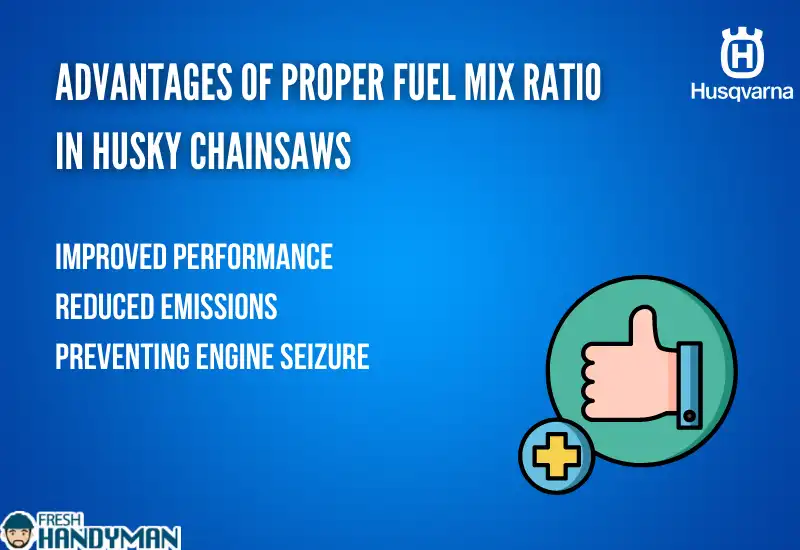
- Improved Performance
A balanced fuel mix ratio ensures that the engine is adequately lubricated, thereby reducing wear and tear. This leads to enhanced performance, including easier starting and smoother operation.
With the right fuel mixture, your Husky saw will also be able to cut better and more efficiently.
- Reduced Emissions
You may not recall, but I mentioned previously that LS+ oil lowers emissions significantly. So if you succeed in getting the ratio right, the power tool won’t emit much pollution.
This not only helps the environment but also protects you from harmful gas emissions.
- Preventing Engine Seizure
Cylinder-piston failure causes chainsaw engines to seize. And what has a direct impact on the piston? Yes, it’s the fuel mixture.
Therefore, if you maintain a good fuel mix, you can prevent engine seizures, which can cause severe damage.
What If Husqvarna Chainsaws Have An Incorrect Fuel Mix Ratio?
The following are the biggest disadvantages of a poor fuel mix.

- Wear and Friction
An incorrect fuel mix ratio can cause the internal parts to wear down more quickly or experience more friction. Consequently, these parts may be damaged or fail, requiring expensive repairs.
- Overheating
When your saw is overheating, you likely don’t attribute it to the fuel mix. However, a bad fuel mix can produce excessive heat in the chainsaw engine; a fact few people are aware of.
- Engine Damage
Engine damage is the most serious consequence of a poor fuel mix ratio.
You see, oil is added to the mixture to lubricate the engine’s internal components. Nevertheless, if there is not enough oil, these items will wear out sooner or seize up.
This way, severe damage to the engine can occur.
Frequently Asked Questions
What happens if I overuse 2-stroke oil?
Using too much 2-stroke oil can lead to several problems, such as decreased engine performance, carbon buildup, and poor fuel economy. The chainsaw may also struggle to start.
Can I use regular gasoline in the fuel mix?
If you own a Husqvarna saw, I strongly recommend using regular unleaded or E10 fuels instead of regular ones. These are the fuels recommended by the manufacturers.
How should I store the fuel mix?
Fill a fuel container with the mixture and store it somewhere cool and dry. It is not advisable to keep fuel for more than one month.
Also Read: Difference Between Husqvarna 440 and 440e
To Sum Up
Hopefully, the article has answered all of your questions about the Husqvarna chainsaw fuel mix ratio.
As I stated earlier, the ideal ratio for Husky units is likely to be 50:1. However, for a few saws, the ratio may shift to 33:1.
Regardless of the fuel mix ratio you select, follow all the instructions carefully to maximize efficiency.

